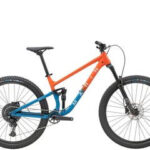Road bikes and mountain bikes stand out as the two most popular types of bicycles available. While both are undeniably bikes, the similarities largely end there. A quick glance reveals stark contrasts: road bikes boast slender frames and thin tires, while mountain bikes are characterized by robust builds and wide, knobby tires. Handlebar shapes differ dramatically, and mountain bikes often feature suspension systems – a feature rarely seen on road bikes.
This article will delve into a comprehensive comparison of road bikes and mountain bikes, highlighting their similarities and, more importantly, their fundamental differences. We’ll explore the design philosophies behind these differences and guide you in determining which type best suits your cycling needs.
It’s important to note that choosing one doesn’t preclude you from enjoying the other. Many cyclists, even professionals, participate in both road and mountain biking disciplines. Notable examples include cycling stars like Mathieu van der Poel, the 2023 world road race champion, and Tom Pidcock, the 2024 Olympic cross-country mountain bike champion, both of whom excel in demanding cross-country mountain biking and grueling road races.
Understanding when to choose a road bike versus a mountain bike is key. While the distinctions extend beyond mere aesthetics and components, let’s begin with the fundamental question of intended use.
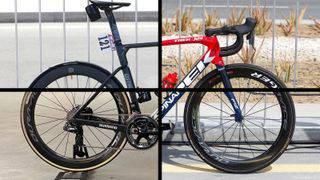 A collection of four distinct road bikes displayed closely together.
A collection of four distinct road bikes displayed closely together.
Purpose-Built: Road Bikes vs. Mountain Bikes
Road bikes are meticulously engineered for speed and efficiency on paved surfaces. This encompasses a wide range of terrains, from smooth city streets and winding country roads to dedicated cycle paths and challenging mountain passes. They prioritize lightweight construction and aerodynamic profiles, enabling riders to achieve high speeds on flat roads and efficiently climb hills. However, their design makes them unsuitable for off-road adventures.
Mountain bikes, conversely, are purpose-built for off-road riding. They are designed to tackle rugged terrain, prioritizing durability, traction, and control over speed on paved surfaces. The wide, knobby tires, while providing excellent grip on trails, create significant rolling resistance on tarmac, making them slow and inefficient on roads. Features like flat handlebars and suspension systems are crucial for enhancing handling and comfort on uneven, technical trails, especially those with steep inclines and obstacles. Mountain bike frame geometry is specifically designed to absorb shocks and maintain balance on bumpy terrain, complemented by powerful disc brakes and wide-ranging gearing systems to conquer diverse off-road challenges.
Frame Geometry: The Blueprint of Bike Behavior
The frame geometry is a foundational aspect differentiating road bikes and mountain bikes. Best road bikes are characterized by compact and aerodynamic frames, prioritizing efficiency and speed. In contrast, mountain bike frames are designed for stability and control over rough terrain.
Road bikes typically feature a longer reach and top tube compared to mountain bikes. This design encourages a stretched-out, aerodynamic riding position, minimizing wind resistance and maximizing power output for speed.
Mountain bikes adopt a shorter reach and top tube, positioning the handlebars closer to the rider. This enhances handling and responsiveness, crucial for navigating tight corners and technical trail features. The more upright riding position, while less aerodynamic, provides better balance and control, particularly on steep descents where a lower center of gravity and rearward weight distribution are advantageous.
Fork offset, also known as fork rake, is another key geometric difference. Road bikes utilize a shorter fork rake, resulting in a steeper fork angle and quicker, more responsive handling. Mountain bikes, conversely, employ a larger fork rake and a slacker head tube angle. This design extends the front wheel further ahead of the frame, improving stability and control, especially on steep downhill sections and technical terrain. This effectively increases leverage and control for the rider.
Trail, a complex measurement derived from head tube angle and fork rake, further distinguishes handling characteristics. Road bikes typically feature a steeper head tube and larger fork offset, resulting in lower trail and quicker handling. Endurance mountain bikes, designed for all-mountain riding, usually have larger trail figures, enhancing stability and high-speed handling on challenging terrain.
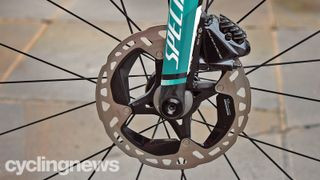 Mountain bike disc brake rotors are prominently displayed at a Tour de France event.
Mountain bike disc brake rotors are prominently displayed at a Tour de France event.
Gearing and Brakes: Power and Control
Modern mountain bikes predominantly utilize a 1x drivetrain setup, featuring a single front chainring. This simplifies shifting, reduces weight, and minimizes the risk of chain derailment, crucial for demanding off-road riding. To compensate for the single front chainring and tackle varied off-road terrain, mountain bikes are equipped with wide-range rear cassettes. These cassettes, sometimes referred to as “dinner plates” due to their size, can feature up to 50-tooth or even larger cogs, providing a vast gear range for steep climbs and fast descents. Manufacturers now offer 11-speed and 12-speed mountain bike cassettes spanning from a 10-tooth to a 50-tooth cog or beyond, ensuring ample gearing even with a 1x system.
Road bike gearing offers greater variety, including compact and race-oriented configurations. Most road bikes employ a 2x drivetrain, featuring two front chainrings and a front derailleur. Common setups include 53/39, 52/36, or 50/34 chainring combinations. Road bike cassettes are typically 11-speed, with ranges from 11-28 or 11-30 teeth, although many riders are opting for wider ranges to aid in climbing steep inclines.
Recreational road cyclists often prefer compact chainring setups, utilizing smaller front chainrings and larger rear cogs. This configuration sacrifices some top-end speed but provides more comfortable pedaling cadences on steep climbs. A compact setup allows riders to maintain an efficient cadence, even on gradients exceeding nine percent.
When it comes to braking, disc brakes are the undisputed standard for mountain bikes. Their superior power, modulation, and consistent performance in wet conditions make them essential for off-road riding. Disc brakes also provide greater tire clearance, accommodating the wide, knobby tires characteristic of mountain bikes. For demanding disciplines like downhill mountain biking, riders often utilize larger disc brake rotors and calipers to enhance stopping power and heat dissipation at high speeds.
While rim brakes were once dominant on road bikes, the benefits of disc brakes on road bikes are now widely recognized. Disc brakes are becoming increasingly prevalent on road bikes across all price points. Despite initial concerns regarding weight, aerodynamics, and safety, advancements in technology have addressed these issues, establishing disc brakes as a mainstream feature on modern road bikes.
Rim brakes remain available on some road bikes, typically offering a lighter weight system compared to disc brakes. However, they suffer from reduced performance in wet conditions, less modulation, and lower overall stopping power. Rim brakes are often chosen for their simplicity, affordability, and ease of maintenance. Furthermore, much existing cycling infrastructure, such as trainers, car racks, and bike stands, is still designed with rim brake compatibility in mind.
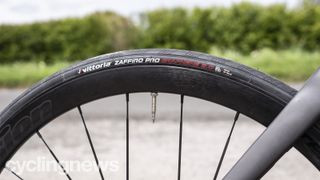 A Cervelo P-Series Ultegra road bike is captured in a detailed studio shot, highlighting its sleek design and components.
A Cervelo P-Series Ultegra road bike is captured in a detailed studio shot, highlighting its sleek design and components.
Wheels and Tires: Rolling Resistance vs. Grip
Mountain bike wheels and tires are built for durability and grip on challenging terrain. They are wider and more robust than road bike counterparts, designed to withstand impacts from rocks, roots, and ruts. Puncture resistance is a key feature, with reinforced sidewalls and aggressive tread patterns.
Mountain bike tire tread patterns vary significantly depending on the intended riding style. Race tires prioritize speed and rolling efficiency, while mud tires offer maximum grip in soft conditions. Downhill tires are designed for extreme grip and durability for aggressive descents. Road tires, in contrast, exhibit less tread variation. The majority are slicks, with minimal tread, often consisting of shallow grooves to channel water in wet conditions. Winter road bike tires may feature slightly more aggressive tread patterns for enhanced grip in cold and slippery conditions.
Best road bike tires are significantly narrower than mountain bike tires, measured in millimeters (mm) rather than inches (in). Road tire widths range from 21mm to 38mm, still considerably narrower than mountain bike tires, which typically start around 2 inches (50mm).
Road bike tires are designed to be inflated to much higher pressures, typically between 50 and 100 PSI. The larger volume of mountain bike tires allows for lower operating pressures (15-35 PSI), enhancing traction, comfort, and performance on rough and uneven surfaces.
Suspension: Smoothing Out the Ride
Suspension is a defining characteristic of mountain bikes, rarely found on road bikes. Mountain bikes are categorized by their suspension systems: hardtail and full suspension.
Hardtail mountain bikes feature front suspension only, typically integrated into the fork. These systems offer travel ranging from 100mm to 170mm, absorbing shocks from bumps and obstacles. Hardtails are lighter than full-suspension bikes, making them popular for cross-country riding and racing where efficiency is paramount.
Full-suspension mountain bikes incorporate both front and rear suspension, significantly enhancing comfort, control, and traction on rough and technical terrain. While heavier and more expensive than hardtails, full-suspension bikes excel in demanding trail riding, downhill mountain biking, and enduro racing. Suspension travel on full-suspension bikes can range from 100mm to 200mm, depending on the intended use.
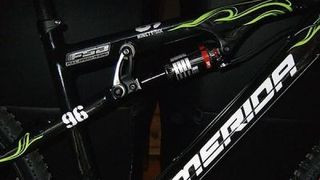 A full-suspension Merida mountain bike is positioned outdoors, highlighting its advanced suspension system.
A full-suspension Merida mountain bike is positioned outdoors, highlighting its advanced suspension system.
Handlebars: Control and Hand Positions
Handlebars represent another significant difference between road and mountain bikes. Road bikes are equipped with drop bars, featuring a curved design that provides multiple hand positions: hoods, drops, and tops. The brake and shift levers are integrated into the hoods, the most frequently used hand position for road cycling. The drops offer a more aerodynamic and powerful position for sprinting and descending, while the tops provide a more upright and relaxed position for climbing and casual riding.
Mountain bikes utilize flat handlebars, extending horizontally across the front of the bike. Flat bars offer a single hand position, with hands placed on either side of the bar. Shift and brake levers are positioned at the ends of the bars for easy access with a finger or thumb.
Flat bars are wider than drop bars, enhancing leverage and control, particularly in tight corners and technical sections. For navigating steep and winding singletrack trails, flat bars offer superior handling compared to drop bars.
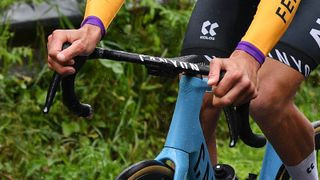 Mathieu Van der Poel is captured riding a Canyon Aeroad road bike, focusing on the handlebar area and his hand position.
Mathieu Van der Poel is captured riding a Canyon Aeroad road bike, focusing on the handlebar area and his hand position.
Riding Position: Aerodynamics vs. Comfort and Control
The riding position differs dramatically between road bikes and mountain bikes. Road bikes promote a stretched-out, forward-leaning posture with a longer reach and a narrower hip angle. This aerodynamic position minimizes wind resistance and maximizes efficiency for speed on paved surfaces.
Mountain bikes, in contrast, encourage a more upright riding position. The shorter reach, slacker head tube angle, and flat handlebars contribute to a more balanced and controlled stance. While less aerodynamic, this upright position enhances comfort and visibility on trails, allowing riders to react quickly to changing terrain. The wider tires and suspension further contribute to comfort on rough surfaces.
Endurance road bikes bridge the gap, offering a more relaxed geometry compared to race-focused road bikes. While less aerodynamic than race bikes, endurance road bikes prioritize comfort for longer rides. They feature a more upright riding position, reducing strain on the back and arms, while retaining key road bike characteristics for speed and efficiency. These bikes are designed for all-day adventures and gran fondos.
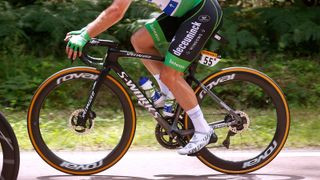 A close-up shot captures the detailed components of a high-end road bike at the Tour de France, emphasizing its cost and performance focus.
A close-up shot captures the detailed components of a high-end road bike at the Tour de France, emphasizing its cost and performance focus.
Making the Choice: Road Bike or Mountain Bike?
The decision between a road bike and a mountain bike ultimately hinges on your intended riding environment. Road bikes are optimized for paved surfaces, while mountain bikes are engineered for off-road trails. If your riding involves a mix of surfaces, a best gravel bikes could be a versatile alternative.
When choosing a new bike, consider the fundamental differences in frame geometry and how they align with your riding style and preferences. Comfort-oriented frame geometry often implies a trade-off in speed, and the off-road capabilities of mountain bikes, including wide tires, suspension, and flat bars, come at the expense of efficiency on pavement.
Both road bikes and mountain bikes offer unique and rewarding cycling experiences. Understanding their distinct characteristics will empower you to select the perfect bike to match your riding aspirations and terrain, ensuring countless miles of enjoyment on two wheels.

